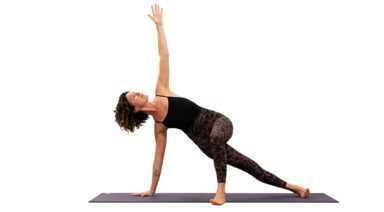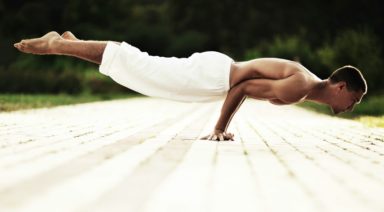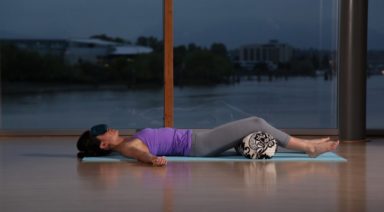Yoga Anatomy: Reducing Shoulder Impingement

![]()
![]()

Our wonderful shoulders are the most mobile joints in the body and, for anyone who has done any amount of Hatha Yoga flow, we can appreciate how much the shoulders are engaged and challenged in our practices. Given how frequently we load and stress the shoulders in yoga, it is ideal to move the shoulders with intelligence, mindfulness, and attentive care. One aspect of mindful movement and engagement is reducing the onset of shoulder impingement.
Our shoulder joints are made from a ‘ball and socket’ design. The upper arm bone (humerus) has defined structures at its proximal end (closest point to the center of the body). At the proximal end of the shaft, we see that the humerus has boney processes (called tubercles where tendons attach). Moving towards the shoulder joint, the humerus has a neck that transitions into a ‘head’ or the ball portion of the joint. The humeral head inserts into the socket (glenoid fossa or cavity) forming this highly moveable joint. The socket is part of the shoulder blade (scapula bone). There is another part of the shoulder blade with a boney projection called the acromion process which is positioned above the humerus. You call feel the acromion process on yourself by taking one hand over and to the back of the shoulder blade. Run your fingers along the shoulder blade to find a horizontal line of bone – this the spine of the scapula. Run your fingers all the way to the end into your shoulder – where this ends is your acromion process.
Between the acromion process and the tubercle region of the humerus is the ‘subacromial space.’ This is where our attention goes regarding shoulder impingement considerations. Deep above the spine of the scapula runs one of your rotator cuff muscles (supraspinatus muscle), which has its tendon traveling through the subacromial space and attaching onto the greater tubercle of the humerus. To offer some protection to this tendon, there is a small sac of fluid (bursa sac) between the tendon and the acromion process.
When we stand in Mountain pose (arms relaxed), there is ample space in the subacromial space for the supraspinatus tendon and the bursa sac. When we lift our upper arm bone outwards (abduction) or towards certain angles of significant forward movement (flexion), the humerus closes into the subacromial space. For some people, due to bone structure and reduced subacromial space, they are more prone to having the tendon and/or bursa sac being compressed and stressed (aka shoulder impingement). With frequent compression, the tendon and/or bursa sac may develop conditions of inflammation. As with any acute or chronic development of shoulder impingement conditions, you will want to consult a qualified health professional for proper assessment and therapeutic treatment.
TRY THESE TECHNIQUES
Knowing the potential for shoulder impingement, we can apply a couple of movement techniques to retain more subacromial space and reduce compression and stress going into the tendon and bursa sac.
External Rotation
The first movement application is external rotation of the humerus, when you abduct and/or deeply flex the shoulder joint. When the upper arm bone internally rotates during abduction and/or flexion, the greater tubercle moves more closely into the subacromial space thus increasing the potential for impingement. When we externally rotate the upper arm bone, it shifts this boney process somewhat away leaving more space for the supraspinatus tendon and bursa sac.
Upwards Rotation
The second movement we can employ is scapular upwards rotation. The shoulder blade can be taken through 6 movements – one of them is an upwards rotation. When we significantly abduct or flex the shoulder joint, we want the shoulder blade to move with the upper arm bone (this is called scapulohumeral rhythm). Besides sustaining more fluid joint congruency and connection during these arm movements, maintaining this joint rhythm reduces the onset of shoulder impingement. Upwards rotation of the scapula is similar to a spinning movement of the shoulder blades away from the spine causing the socket and acromion process (all connected as one bone) to tilt upwards. The upwards lift of the acromion retains space in the subacromial space as the arm bone lifts through abduction or flexion.
When we combine external rotation of the shoulder with upwards scapular abduction, this becomes a movement of integrity and beauty for the shoulder joint – retaining space while enhancing stability. Consider all the yoga postures and transitions where you can take advantage of this movement combination: sun salutation arm circles; downward facing dog; tree pose; crescent lunge/warrior 1; half moon; and other reaching side bends.
Play with these movements in the shoulder and shoulder girdle. Keep in mind that bone structure can be highly variable, therefore some people benefit more from these movement applications than others. Also examine with these movements how the rest of the body (and kinetic chain of other joints involved like the elbow and wrist) is affected. Rarely in yoga are movements tightly isolated in one joint region. As you find your way into postures, maintain ease and playfulness (versus rigidity) as this will greatly increase your capacity to explore these techniques towards spaciousness and integrity.
Explore the Anatomy and Correct Alignment of Headstand Pose

Knowledge dissolves fear. With a basic understanding of the structures in your neck, and application of these five keys, one can practice sirsasana safely.
Let’s first take a look at the anatomy, and the neck’s role in our daily life.
The seven little bones of the cervical spine (neck bones) are unique in that they are designed for mobility rather than stability. Like other joints in the body, where stability is sacrificed for mobility, the primary purpose of the C spine in daily life is ease of movement. Therefore, ideal alignment and muscular harmony are particularly important.
The load bearing structures of a cervical vertebrae are the body and two articular facets. A typical cervical vertebral body is approximately two centimeters in diameter depending on the vertebrae (C3 – C7), gender, and individual differences. This is comparable to the diameter of a dime. One may make the comparison of a lumbar vertebral body and cervical vertebral body to the chunky heel of a walking shoe to a high heeled pump. Imagine walking a gravel road in stilettos versus the former.
Another feature worth noting is that the C spine houses the vertebral arteries. Transverse foramen, or holes from top to bottom on the side wings of the bones, house this paired blood vessel which travels up to the brain, taking a rather alarming posterior jog at the top of the neck bones before entering the skull. Symptoms of blocking this small artery include dizziness, blurred vision and occipital headaches. Any lesion compromising the integrity of this passage way is exacerbated by misalignment and the additional and uncustomary weight of your body on the cervical vertebrae in a posture like sirsasana.
Nerves exit the intervertebral foramen (holes in the sides between the neck bones), the branches of which pass laterally between the anterior and middle scalene muscles. These muscles help to hold your head and neck up like guide wires, and provide movement in your neck. Overuse these muscles through misalignment or overload them, and they will become inflamed or tight, possibly pinching the nerves.
How to Safely Practice Headstand (Sirsasana)
Armed with this information, how can you incorporate sirsasana safely into your practice? Headstand or any posture for that matter doesn’t have to look like the pose in your yoga syllabus to start. Practice the actions of the pose in a modification, and you will receive more benefit than forcing the pose.
Here are some important points to practice sirsasana.
1. A strong headstand begins with sensible upright posture.
Carry your upper palate above your physical heart. Assume a natural lordosis in your neck. Your best posture will be your tallest, most easeful posture. Maintain this easeful alignment of your spine in upright yoga postures. If you don’t know what good alignment feels like upright, you won’t know what it feels like upside down.
Practice holding Tadasana in ideal alignment and full attention for several minutes. To simulate the postural muscles further, root down from the outer hips into your feet. Place a block on top of your head while standing, and root up into it from your upper palate as you gently resist. Breathe fully to expand and lengthen your torso. Drop your shoulders away from your ears, and slide the upper arms back to widen the clavicles (collar bones). Invite the ribs back, as this action tends to cause them to splay forward. Breathe into your back, particularly just above the waist.
Practice integrating your body from head to feet with these polar actions of rooting and lifting. When you are in perfect alignment, your body will feel like your favorite pair of walking shoes: No friction, no effort, just ease.
Which brings me to the next key.
2. Stretch your hamstrings and plantar fascia.
To get into any posture, the closer to ideal postural alignment you can get, the less likelihood of injury. To keep your neck safe in headstand, you need to be able to align your entire spine before taking away the support of your feet. In order to achieve this, the back of your legs and soles of your feet must be supple enough to walk into the posture without rounding the lower back and therefore the neck.
3. Apply the rules of progressive overload.
No one walks into a gym and does a clean and jerk with 150 pounds off the bat with no experience. So why would headstand be any different? The neck is accustomed to bearing a mere ten pounds of weight. Add resistance incrementally in weight and duration.
4. Create a stable foundation.
** **When you are ready to do sirsasana, interlace your fingers into prayer hands, with the exception of your pinky fingers. Your pinky fingers should be stacked, overlapping each other front to back. You should be able to see both middle fingers from above but not any of your palm to start–so slightly pronate your forearms. Once you tuck your head into your palms, the tendency is to roll onto the dorsum (back) of your hand. Starting in slight pronation will bring you into neutral alignment once you are in the posture. Now root down through parallel upper arms into the forearms, wrists and hands while keeping the spine neutral and your chest open. Nestle the back of your head into your hands. Distribute the weight between the crown of your head, forearms, wrists and hands.
5. Keep your mouth shut.
This one is mostly for teachers. Although designed primarily to aid in tongue movement and swallowing, the variety of muscles attached to the base of the tongue help to support your neck. Anchor the tongue to the roof of your mouth for additional stability. When it comes to standing on your head, recruit as much help as possible. So teachers, explain your demo first, and don’t speak once you are in the posture.
Precautions and Contraindications
There are precautions and contraindications to performing sirsasana, such as osteoarthritis of the C spine, any autoimmune disease affecting the musculoskeletal system, diabetes, heart condition, degenerated discs, down syndrome, or any other pathology affecting the neck.
However, even with these conditions, one can enjoy many of the benefits of the pose by simply embodying the actions of the pose in a modified form. With patience and keen attention, headstand can be performed safely to benefit your wellbeing.
Naomi Friesen possesses a deep understanding of the physical body through 20 years of teaching movement and anatomy. Students benefit from her knowledge of sound biomechanics by receiving safe and effective instruction. A personal trainer, pilates instructor and lifestyle/weight management coach for 12 years, she now teaches yoga after receiving her yoga instructor certification through Open Source Yoga School. Naomi’s intention is to facilitate connection for herself and students through yoga – connection to Source, connection between the parts of our body, our connection to others.
Website: www.victoriaschoolofyoga.com
Facebook: Victoria School of Yoga




































